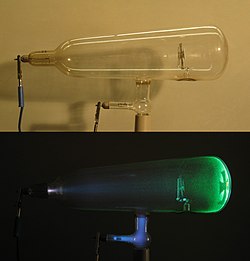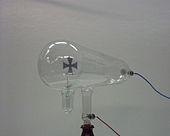
Back أنبوب كروكس Arabic Tub de Crookes Catalan Crookesova trubice Czech Schattenkreuzröhre German Tubo de Crookes Esperanto Tubo de Crookes Spanish Crookes hodi Basque لامپ کروکز Persian Tube de Crookes French Crookesova cijev Croatian

A Crookes tube (also Crookes–Hittorf tube)[1] is an early experimental electrical discharge tube, with partial vacuum, invented by English physicist William Crookes[2] and others around 1869–1875,[3] in which cathode rays, streams of electrons, were discovered.[4]
Developed from the earlier Geissler tube, the Crookes tube consists of a partially evacuated glass bulb of various shapes, with two metal electrodes, the cathode and the anode, one at either end. When a high voltage is applied between the electrodes, cathode rays (electrons) are projected in straight lines from the cathode. It was used by Crookes, Johann Hittorf, Julius Plücker, Eugen Goldstein, Heinrich Hertz, Philipp Lenard, Kristian Birkeland and others to discover the properties of cathode rays, culminating in J. J. Thomson's 1897 identification of cathode rays as negatively charged particles, which were later named electrons. Crookes tubes are now used only for demonstrating cathode rays.
Wilhelm Röntgen discovered X-rays using the Crookes tube in 1895. The term Crookes tube is also used for the first generation, cold cathode X-ray tubes,[5] which evolved from the experimental Crookes tubes and were used until about 1920.
- ^ T. A. Delchar, Physics in Medical Diagnosis, Springer, 1997, p. 135.
- ^ Crookes, William (December 1878). "On the illumination of lines of molecular pressure, and the trajectory of molecules". Phil. Trans. 170: 135–164. doi:10.1098/rstl.1879.0065. S2CID 122178245.
- ^ "Crookes Tube". The New International Encyclopedia. Vol. 5. Dodd, Mead & Co. 1902. p. 470. Retrieved 2008-11-11.
- ^ "Crookes tube". The Columbia Electronic Encyclopedia, 6th Ed. Columbia Univ. Press. 2007. Retrieved 2008-11-11.
- ^ Mosby's Dental Dictionary, 2nd ed., 2008, Elsevier, Inc. cited in "X-ray tube". The Free Dictionary. Farlex, Inc. 2008. Retrieved 2008-11-11.



